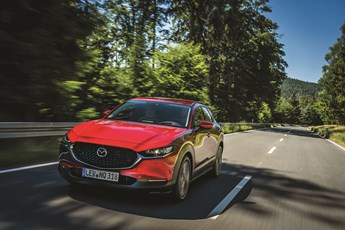
The start point for the best source of fleet information |
Mazda CX-30
Date: 27 August 2019 | Author: Rachel Boagey

|
|
||||||||||||||||||||||||||||
The Mazda CX-30 might be a brand new model for Mazda but there is no denying that it has arrived long after the buffet food was eaten at the family crossover party.
But it's turning up that counts, right? And could Mazda's efforts with the new crossover be just what the market was waiting for?
To all intents and purposes, yes, the CX-30 is a crossover (i.e. slightly fatter) version of the Mazda3, but with its plumped up physique comes increased practicality, and testing it on the roads surrounding Frankfurt we soon discovered it is very nearly as good to drive too.
With body control more akin to a family hatchback than an SUV, the engineering of the CX-30, which feels like it has been mastered by people who really love to drive, ensures it doesn't roll around too much on corners, and feels steady and secure to drive. It also has a general sense of comfort and smoothness, although driving it on German roads around Frankfurt may be a little more generous
to the car than those pothole-ridden ones we get in the UK. While the steering might not feel particularly quick, it is precise and nicely-weighted around corners, and reminds you of the emphasis Mazda places on driving experience.
The CX-30 offers a 430-litre boot, which is 72 litres bigger than its 3 sibling, despite being both shorter overall with a smaller wheelbase, although it is naturally quite a bit taller, ensuring increased headroom for passengers. However, competition in this small SUV class is fierce, and Mazda has decided to prioritise the CX-30's sleek design over outright practicality, meaning its 430 litres is quite a bit less than the 521 offered in the Skoda Karoq. Another differing factor from the 3 is the visibility that you gain when sitting in the CX-30. In the 3, we found the A-pillars to be quite intrusive and over-the-shoulder visibility wasn't great either - both problems are solved in this crossover.
It is also similar to the 3 in terms of its engine line-up, using the 1.8-litre diesel and a couple of petrols too. One of them is the painfully underpowered 2.0-litre unit, but that is where the similarities end, and the CX-30 reveals an important string to its bow. The other petrol engine on offer is a much more interesting engine called Skyactiv-X. Mazda's next step in its mission against the trend for downsized turbocharged petrol engines is to come up with new technology for a petrol engine to deliver the fuel economy of a diesel.
Without delving too much into the technical details, Skyactiv-X is effectively a petrol engine that uses diesel-style compression ignition. According to Mazda's powertrain engineers, the general idea is that you get the lower end torque characteristic of a diesel, but the refinement and pull of a petrol. The 2.0-litre unit offers 180hp, but to be honest, it doesn't feel anywhere near that powerful. Luckily, by going through the menu on the infotainment screen to 'efficiency', you can watch an interactive image of what is going on under the bonnet, but other than that, you really wouldn't know that clever things are taking place.
It is the diesel that really shines in this car as the engine of choice. It has more torque and pulling power than both of the petrols, and feels more suited to the character and style of this crossover, especially when mated with the AWD system offered in the CX-30, which you don't get in the 3. As for the six-speed automatic transmission, it is really smooth and decisive, and well matched to the diesel engine.
The equipment levels haven't been released yet, but expect them to be the same as in the 3. However, opting for the CX-30 means a £2,000-3,000 premium in comparison with the 3, edging it into premium crossover territory. That makes it more expensive than an equivalent Qashqai; however, the feeling of quality and refinement in this car means you definitely feel like you are getting what you paid for. Materials are strong and high-quality, switches operate satisfyingly and are logically laid out, and the new 8.8in infotainment display looks good and is easy to use.
You will be glad to know that the CX-30 definitely steps on the toes of premium rivals in terms of luxury, and is way ahead of its more mainstream rivals in that department. Nearly everything is soft touch, and it feels like a lot of time and effort went into the design inside and out, except for that awful black cladding . . .
We are still waiting for the economy figures for the CX-30, but you can expect it to be among the most affordable compact SUVs on the market in that respect. Even the thirstiest Skyactiv-G 2.0-litre petrol can manage a respectable 53.3mpg with FWD and a manual gearbox. The anticipated Skyactiv-X engine is expected to have the lowest CO2 emissions, but alternatively, opting for the 1.8-litre diesel we drove here can return up to 57.6mpg, with CO2 emissions from around the 120g/km mark.
Mazda is yet to release pricing, but if it is a high-quality SUV you're after with copious amounts of driver appeal too, the CX-30 should definitely be on your shortlist.
Mazda CX-30 115hp diesel
P11D TBC
On sale Late 2019
Residual value TBC
Depreciation TBC
Fuel TBC
Service, maintenance and repair TBC
Cost per mile TBC
Fuel consumption 57.6mpg (estimate)
CO2 (BIK band) 120g/km (28%) (estimate)
BIK 20/40% a month TBC
Boot space 430 litres
Engine size/power 1,998cc/115hp
Verdict |
8/10 |
|||
 |
|
 |
|
|










